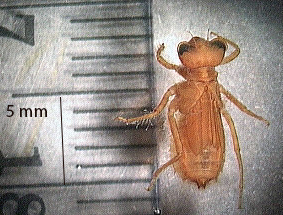 Aquatic Insects of Michigan
Aquatic Insects of Michigan
by Ethan Bright, Museum of Zoology Insect Division and School of Natural Resources and Environment
University of Michigan
- Home
- Species Lists
- Coleoptera
- Diptera
- Ephemeroptera
- Acanthametropodidae
- Ameletidae
- Ametropodidae
- Arthropleidae
- Baetidae
- Baetiscidae
- Behningiidae
- Caenidae
- Ephemerellidae
- Ephemeridae
- Heptageniidae
- Isonychiidae
- Leptohyphidae
- Leptophlebiidae
- Metretopodidae
- Neoephemeridae
- Oligoneuriidae
- Palingeniidae
- Polymitarcyidae
- Potamanthidae
- Pseudironidae
- Siphlonuridae
- Heteroptera
- Hymenoptera
- Lepidoptera
- Megaloptera
- Neuroptera (Sisyridae)
- Odonata
- Orthoptera
- Plecoptera
- Trichoptera
- Other Orders
- Keys/Identification
- Aquatic Insects of Michigan
Nannothemis bella (Elfin Skimmer) in Michigan - Identification
Introduction
[under construction]
Michigan's smallest dragonfly, this species is found around bogs, fens and sometimes sandy lakes. Usually not encountered by most collectors, this species is widely dispersed in our state and is probably common especially in poor fens and bogs with suitable habitat.
Adults are tiny, less than 2.5 cm long, with small clear or amber-tinged wings reduced such that the wing's anal loop is incomplete and the forewing triangle small. Males, initially blackish, develop after a week to a powdery blue with a widened abdomen, with lighter bands on the posterior margin of each segment. Females appear as wasp-mimics, black mottled with yellow, with a black abdomen with yellow banding (becoming narrower posteriorly) on each segment (Paulson 2011).
Walker and Corbet (1975) report this species being common in floating sphagnum bogs, where females oviposit in warm temporary water 2-5 cm deep. Mature nymphs do not exceed 11 mm in length. (Maturity is recognized when the wing sheaths reach abdominal segment 6). Larval habitat appears to be small pools and puddles away from the water's edge in the sphagnum of fens and bogs. Although numerous adults specimens from Michigan are in various institutional collections (Kielb 1997), few larval specimens exist undoubtedly due to poor collecting effort and difficulty of finding this species' evidently specific microhabitat. I (EB) have collected in Washtenaw County, southeastern Michigan, nearly mature larval specimens in a habitat resembling that described by Walker and Corbet. Nymphs were collected in water-filled depressions on a floating mat composed of Carex sp. and Sphagnum sp., with leatherleaf around the edges, in the middle of an large pond. The water-filled depressions, sometimes quite small, of the Spahgnum had a pH of 5.1, conductivity of 30 uS cm-1, and an alkalinity of only about 1-2 mg/l CaCO3. Both mature and considerably less-developed specimens were collected, suggesting perhaps either a two-year life cycle or two different populations. N. bella appear common in these holes, but are very difficult to find. Apart from their very small size, disturbed nymphs "freeze," which makes them difficult to find among the sphagnum debris, even when submerged in water. Some live larvae put in a container filled with sphagnum slowly burrowed into the debris, their bodies, being densely covered with attached particulate matter, soon became rather cryptic. Emergence is probably from early to late-June, earlier in southern Michigan, later further north. However, in 1998, which was a very early year, I (EB) collected an adult in the third week of May in Lenawee County.
References
-
Kielb MA. 1997. Nannothemis bella (Uhler) in Michigan (Libellulidae). Williamsonia 1(2):4.
Needham JG, Westfall MJ, May ML. 2010. Dragonflies of North America. The Odonata (Anisoptera) fauna of Canada, the Continential United States, Northern Mexico and the Great Antilles. Third Edition. Scientific Publishers: Gainesville, Florida. xiv + 658.
Paulson D. 2011. Dragonflies and damselflies of the East. Princeton Field Guides. Princeton University Press, Pinceton, New Jersey, USA. 538 p.
Walker EM, Corbet JS. 1975. The Odonata of Canada and Alaska, Vol. 3. University of Toronto Press: Toronto, Ontario. xvi + 308.
Last updated: February 19, 2017 (EB)